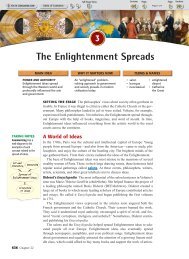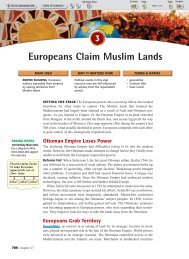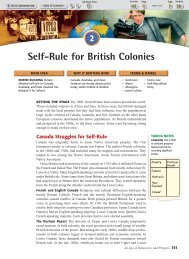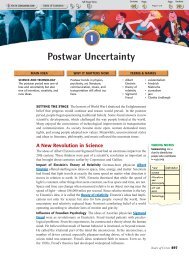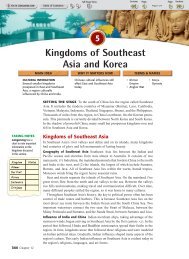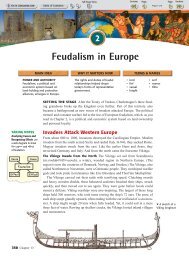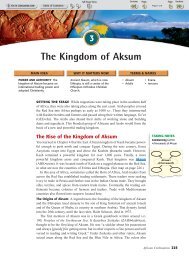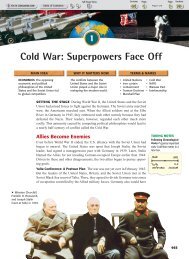The Beginnings of Industrialization - Euro-webonline.com
The Beginnings of Industrialization - Euro-webonline.com
The Beginnings of Industrialization - Euro-webonline.com
Create successful ePaper yourself
Turn your PDF publications into a flip-book with our unique Google optimized e-Paper software.
An English<br />
farmer plants his<br />
fields in the early<br />
1700s using a<br />
seed drill.<br />
▲<br />
Livestock breeders improved their methods too. In the 1700s, for example,<br />
Robert Bakewell increased his mutton (sheep meat) output by allowing only his<br />
best sheep to breed. Other farmers followed Bakewell’s lead. Between 1700 and<br />
1786, the average weight for lambs climbed from 18 to 50 pounds. As food supplies<br />
increased and living conditions improved, England’s population mushroomed.<br />
An increasing population boosted the demand for food and goods such as cloth. As<br />
farmers lost their land to large enclosed farms, many became factory workers.<br />
Why the Industrial Revolution Began in England In addition to a large population<br />
<strong>of</strong> workers, the small island country had extensive natural resources.<br />
<strong>Industrialization</strong>, which is the process <strong>of</strong> developing machine production <strong>of</strong><br />
goods, required such resources. <strong>The</strong>se natural resources included<br />
•water power and coal to fuel the new machines<br />
• iron ore to construct machines, tools, and buildings<br />
•rivers for inland transportation<br />
• harbors from which merchant ships set sail<br />
In addition to its natural resources, Britain had an expanding economy to support<br />
industrialization. Businesspeople invested in the manufacture <strong>of</strong> new inventions.<br />
Britain’s highly developed banking system also contributed to the country’s industrialization.<br />
People were encouraged by the availability <strong>of</strong> bank loans to invest in<br />
new machinery and expand their operations. Growing overseas trade, economic<br />
prosperity, and a climate <strong>of</strong> progress led to the increased demand for goods.<br />
Britain’s political stability gave the country a tremendous advantage over its<br />
neighbors. Though Britain took part in many wars during the 1700s, none occurred<br />
on British soil. <strong>The</strong>ir military successes gave the British a positive attitude.<br />
Parliament also passed laws to help encourage and protect business ventures. Other<br />
countries had some <strong>of</strong> these advantages. But Britain had all the factors <strong>of</strong> production,<br />
the resources needed to produce goods and services that the Industrial<br />
Revolution required. <strong>The</strong>y included land, labor, and capital (or wealth).<br />
Recognizing<br />
Effects<br />
How did population<br />
growth spur<br />
the Industrial<br />
Revolution?<br />
Inventions Spur <strong>Industrialization</strong><br />
In an explosion <strong>of</strong> creativity, inventions now revolutionized industry. Britain’s<br />
textile industry clothed the world in wool, linen, and cotton. This industry was the<br />
first to be transformed. Cloth merchants boosted their pr<strong>of</strong>its by speeding up the<br />
process by which spinners and weavers made cloth.<br />
Changes in the Textile Industry As you will learn in the feature on textile technology<br />
on page 719, by 1800, several major inventions had modernized the cotton<br />
industry. One invention led to another. In 1733, a machinist named John Kay made<br />
a shuttle that sped back and forth on wheels. This flying shuttle, a boat-shaped piece<br />
718 Chapter 25



